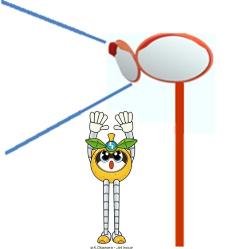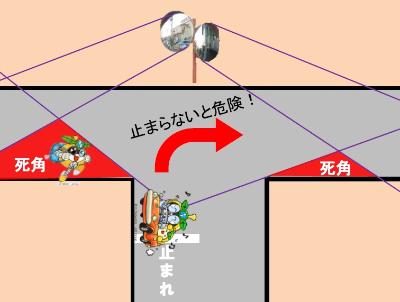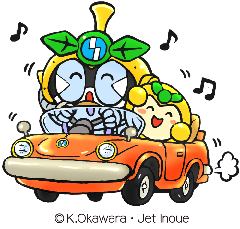curve-mirror
Updated: April 24, 2018
What is a curved mirror?
curve-mirror
Curve mirrors are facilities for traffic safety that are installed for the purpose of checking other vehicles that are out of sight of car drivers at intersections, road bends, sharp curves, and other places with poor visibility. It has been established by the Tokyo Metropolitan Government.
The city is working to improve traffic safety by installing curved mirrors in places where drivers cannot see clearly when driving on city roads.
In addition to curved mirrors installed by the city, there are also curved mirrors installed and maintained by individuals to ensure visibility from private property such as entrances to private parking lots.
Curved mirrors are very convenient for recognizing the presence or absence of approaching vehicles in advance, but they also have the following dangers.
The dangers of convex mirrors
Danger 1 “Blind spot”

I'm in a "blind spot"
Curved mirrors have a "blind spot" where the image is not reflected on the mirror surface.
Be especially careful in areas where many children pass by.
Because children are short, they end up in the "blind spot" of curved mirrors.
Even if the driver of the car confirms that there are no other vehicles approaching by looking at the curve mirror, he or she assumes that there may be children hiding in the "blind spot" and continues to drive at a speed that allows him or her to stop quickly. However, it is necessary to visually check the safety with your own eyes.
Danger 2: “Cars that won’t stop”

Convex mirrors induce drivers to not stop
Generally, car drivers stop or slow down at intersections with poor visibility where curved mirrors are not installed, and drive while visually confirming safety, but when curved mirrors are installed, Since you can check from the front that there are no cars approaching, you tend to enter the intersection without slowing down.
In this case, if the speed of the vehicle is high and a collision occurs with a pedestrian or other person in the "blind spot," the injury will be serious.
In this case, curved mirrors, which are originally installed for safety, end up increasing the danger of traffic, which puts the cart before the horse.
Curved mirrors are merely an auxiliary facility for traffic safety, and the information obtained from curved mirrors is only for reference.In the end, drivers should stop or drive slowly and visually check the information with their own eyes. It is necessary to check the safety directly.
Summary of dangers

Recently, it has gradually become recognized that curved mirrors for traffic safety can sometimes cause traffic accidents.
Curved mirrors are only an auxiliary facility for traffic safety.
In order to prevent tragic accidents from occurring, it is essential to check the safety directly with your own eyes.
Please drive safely and don't forget to slow down or stop just because you have a curved mirror.
When the city installs curved mirrors
The city takes the dangers of curved mirrors very seriously and makes careful decisions when installing curved mirrors.
The following conditions apply to installing a curved mirror.
Target road
Target roads must meet both 1 and 2 below.
1 A road that is wide enough that the installation of curved mirrors will not impede vehicle traffic.
2 If any of the following applies (1) City roads (including when entering and exiting public facilities)
(2) Metropolitan road (if it intersects with a city road)
(3) A private road where an unspecified number of vehicles can pass (if it intersects with a city road)
Consideration based on road shape
Among the "target roads" listed above, we will consider installing curved mirrors if the viewing distance cannot be secured due to the influence of the following road shapes.
(1) Curved or bent parts (curved parts or L-shaped bent parts)
(2) When there is no corner cut.
(3) When there is no sidewalk on the road on the crossing side.
If not installed due to environmental factors
Even if the above conditions are met, the product will not be installed in the following locations.
(1) Roads with “stop” traffic regulations
Curved mirrors will not be installed at intersections where there is a "stop" traffic regulation, as this may encourage non-stop traffic and cause a more serious accident.
(2) Roads near elementary school routes and children's centers As a general rule, they are not installed in areas where there are many small children passing through, as short children may end up in the "blind spot", which is dangerous.
(3) It will not be installed if it interferes with the use of adjacent land or buildings.
[FAQ1] Even if I stop at the stop line, I can't see the car coming. Could you please install a curved mirror?
[Answer]
When there is a "stop" traffic regulation, drivers must stop their vehicles immediately before the stop line.
Stop lines are placed before intersections, so cars on the intersecting road cannot usually be seen from the stop location, so curved mirrors are not installed.
Even after stopping, the driver should drive slowly and continue forward while visually confirming safety, and if there is a risk of obstructing the progress of vehicles passing through the intersecting road, the driver should take measures such as stopping again. Must be.
In addition, as mentioned above in "Dangers of curved mirrors", if curved mirrors are installed at intersections with "stop" traffic regulations, they may induce people to drive without stopping or slowing down, and the curved mirrors may Curved mirrors are not installed in places where there are temporary stopping regulations, as there is a risk of a more serious accident occurring than if there were no mirrors.
[FAQ2] There are intersections where accidents can actually occur and are dangerous. Can you install a curved mirror?
[Answer]
Curved mirrors will not be installed just because there has been an accident.
Installing curved mirrors may encourage drivers to drive without stopping or slowing down, which may lead to more serious accidents than if there were no curved mirrors, so we consulted with the Tama Chuo Police Station. However, I will consider it carefully.
Inquiries regarding this page
Inagi City Urban Construction Department Management Division
2111 Higashinagumanuma, Inagi City, Tokyo
Phone: 042-378-2111 Fax: 042-377-4781







